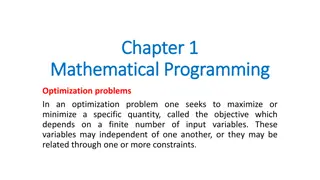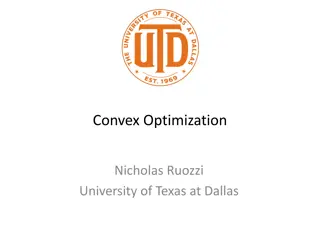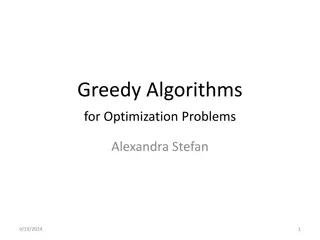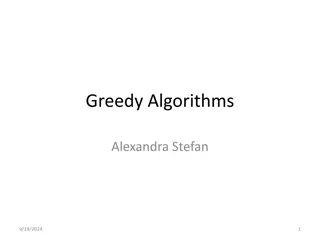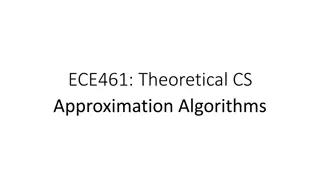Understanding Optimization Techniques for Design Problems
Explore the basic components of optimization problems, such as objective functions, constraints, and global vs. local optima. Learn about single vs. multiple objective functions and constrained vs. unconstrained optimization problems. Dive into the statement of optimization problems and the concept of objective function surfaces in a graphical context.
Download Presentation

Please find below an Image/Link to download the presentation.
The content on the website is provided AS IS for your information and personal use only. It may not be sold, licensed, or shared on other websites without obtaining consent from the author. Download presentation by click this link. If you encounter any issues during the download, it is possible that the publisher has removed the file from their server.
E N D
Presentation Transcript
OPTIMIZATION TECHNIQUES
Objective Function, Maxima, Minima and Saddle Points, Convexity and Concavity
3 Objectives Study the basic components of an optimization problem. Formulation of design problems as mathematical programming problems. Define stationary points Necessary and sufficient conditions for the relative maximum of a function of a single variable and for a function of two variables. Define the global optimum in comparison to the relative or local optimum Determine the convexity or concavity of functions
4 Introduction - Preliminaries Basic components of an optimization problem : An objective function expresses the main aim of the model which is either to be minimized or maximized. Set of unknowns or variables which control the value of the objective function. Set of constraints that allow the unknowns to take on certain values but exclude others. Optimization problem is then to: Find values of the variables that minimize or maximize the objective function while satisfying the constraints.
5 Objective Function Many optimization problems have a single objective function The two interesting exceptions are: No objective function: User does not particularly want to optimize anything so there is no reason to define an objective function. Usually called a feasibility problem. Multiple objective functions. In practice, problems with multiple objectives are reformulated as single-objective problems by either forming a weighted combination of the different objectives or by treating some of the objectives by constraints.
6 Statement of an optimization problem x 1 x 2 . To find X = which maximizes f(X) . nx Subject to the constraints gi(X) <= 0 , i = 1, 2, .,m lj(X) = 0 , j = 1, 2, .,p
7 Statement of an optimization problem where X is an n-dimensional vector called the design vector f(X) is called the objective function gi(X) and lj(X) are inequality and equality constraints, respectively. This type of problem is called a constrained optimization problem. Optimization problems can be defined without any constraints as well Unconstrained optimization problems.
8 Objective Function Surface If the locus of all points satisfying f(X) = a constant c is considered, it can form a family of surfaces in the design space called the objective function surfaces. When drawn with the constraint surfaces as shown in the figure we can identify the optimum point (maxima). Possible graphically only when the number of design variable is two. When we have three or more design variables because of complexity in the objective function surface we have to solve the problem as a mathematical problem and this visualization is not possible.
9 Objective function surfaces to find the optimum point (maxima)
10 Variables and Constraints Variables These are essential. If there are no variables, we cannot define the objective function and the problem constraints. Constraints Even though constraints are not essential, it has been argued that almost all problems really do have constraints. In many practical problems, one cannot choose the design variable arbitrarily. Design constraints are restrictions that must be satisfied to produce an acceptable design.
11 Constraints (contd.) Constraints can be broadly classified as : Behavioral or Functional constraints : Represent limitations on the behavior and performance of the system. Geometric or Side constraints : Represent physical limitations on design variables such as availability, fabricability, and transportability.
12 Constraint Surfaces Consider the optimization problem presented earlier with only inequality constraints gi(X) . Set of values of X that satisfy the equation gi(X) forms a boundary surface in the design space called a constraint surface. Constraint surface divides the design space into two regions: one with gi(X) < 0 (feasible region) and the other in which gi(X) > 0 (infeasible region). The points lying on the hyper surface will satisfy gi(X) =0.
13 The figure shows a hypothetical two-dimensional design space where the feasible region is denoted by hatched lines Behavior constraint g2 0 Infeasible region Side constraint g3 0 Feasible region Behavior constraint g1 0 . . Bound acceptable point. Free acceptable point Bound unacceptable point. Free unacceptable point
14 Stationary Points: Functions of Single and Two Variables
15 Stationary points For a continuous and differentiable function f(x) a stationary point x*is a point at which the function vanishes, i.e. f (x) = 0 at x = x*. x*belongs to its domain of definition. Stationary point may be a minimum, maximum or an inflection (saddle) point
Stationary points ( ) 0 x = f ( ) ( ) 0 , f x ( ) 0 x ( ) 0 x f f 0 f x ( ) ( ) 0 x 0 , f x ( ) 0 x ( ) ( ) ( ) 0 x = 0 , f f x f f ( ) 0 x = f = 0 f x (a) Inflection point (b) Minimum (c) Maximum
17 Relative and Global Optimum Afunction is said to have a relative or local minimum at x = x*if for all sufficiently small positive and negative values of h, i.e. in the near vicinity of + * the point x. ( ) f x ( ) f x h A point x*is called a relative or local maximum if for all values of h sufficiently close to zero. + * ( ) f x ( ) f x h A function is said to have a global or absolute minimum at x = x*if for all x in the domain over which f(x) is defined. A function is said to have a global or absolute maximum at x = x*if ( ) ( ) f x f x * for all x in the domain over which f (x) is defined. * ( ) f x ( ) f x
18 Relative and Global Optimum A1, A2, A3= Relative maxima A2= Global maximum B1, B2= Relative minima B1= Global minimum . Relative minimum is also global optimum A2 . f(x) f(x). . A3 A1 . B2 . B1 x a a b b x
19 Functions of a single variable a x b Consider the function f(x) defined for [ , ] a b To find the value of x* such that x*maximizes f(x) we need to solve a single-variable optimization problem.
20 Functions of a single variable Necessary condition : For a single variable function f(x) defined for x which has a relative maximum at x = x*, x* derivative f (x) = df(x)/dx exists as a finite number at x = x*then [ , ] a b [ , ] a b if the f (x*) = 0. Above theorem holds good for relative minimum as well. Theorem only considers a domain where the function is continuous and derivative. It does not indicate the outcome if a maxima or minima exists at a point where the derivative fails to exist. This scenario is shown in the figure below, where the slopes m1 and m2at the point of a maxima are unequal, hence cannot be found as depicted by the theorem.
21 Functions of a single variable . Salient features: Theorem does not consider if the maxima or minima occurs at the end point of the interval of definition. Theorem does not say that the function will have a maximum or minimum at every point where f (x) = 0, since this condition f (x) = 0 is for stationary points which include inflection points which do not mean a maxima or a minima.
22 Sufficient condition For the same function stated above let f (x*) = f (x*) = . . . = f(n-1)(x*) = 0, but f(n)(x*) 0, then it can be said that f (x*) is (a) a minimum value of f (x) if f(n)(x*) > 0 and n is even (b) a maximum value of f (x) if f(n)(x*) < 0 and n is even (c) neither a maximum or a minimum if n is odd
23 Example 1 = + Find the optimum value of the function and also state if the function attains a maximum or a minimum. 2 ( ) f x 3 5 x x Solution = 3 0 + = '( ) f x 2 x For maxima or minima, or x*= -3/2 ''( *) x = 2 f is positive . Hence the point x*= -3/2 is a point of minima and the function attains a minimum value of -29/4 at this point.
24 Example 2 Find the optimum value of the function and also state if the function attains a maximum or a minimum = 4 ( ) f x ( 2) x Solution: f x = = 3 '( ) 4( 2) 0 x or x = x*= 2 for maxima or minima. ''( *) 12( * 2) x = = 2 0 f x at x*= 2 = = '''( *) x ( ) x 24( * 2) x 0 f at x*= 2 *= 24 f at x*= 2 Hence fn(x) is positive and n is even hence the point x = x* = 2 is a point of minimum and the function attains a minimum value of 0 at this point. More examples can be found in the lecture notes
25 Functions of two variables Concept discussed for one variable functions may be easily extended to functions of multiple variables. Functions of two variables are best illustrated by contour maps, analogous to geographical maps. A contour is a line representing a constant value of f(x) as shown in the following figure. From this we can identify maxima, minima and points of inflection. A contour plot
26 Necessary conditions From the above contour map, perturbations from points of local minima in any direction result in an increase in the response function f(x), i.e. the slope of the function is zero at this point of local minima. Similarly, at maxima and points of inflection as the slope is zero, the first derivative of the function with respect to the variables are zero. Which gives us at the stationary points. i.e. the f x f = = 0; 0 x 1 2 gradient vector of f(X), at X = X*= [x1 , x2] defined as follows, must equal zero: f x f f x xf ( *) 1 = = 0 x ( *) 2
27 Sufficient conditions Consider the following second order derivatives: 2 2 2 f f f ; ; x x 2 1 2 2 x x 1 2 Hessian matrix defined by H is formed using the above second order derivatives. 2 2 f f x x 2 1 f x 1 2 2 = H 2 f x x 2 2 x 1 2 [ , ] x x 1 2
28 Sufficient conditions The value of determinant of the H is calculated and if H is positive definite then the point X = [x1, x2] is a point of local minima. if H is negative definite then the point X = [x1, x2] is a point of local maxima. if H is neither then the point X = [x1, x2] is neither a point of maxima nor minima.
Example Locate the stationary points of f(X) and classify them as relative maxima, relative minima or neither based on the rules discussed in the lecture. = X /3 2 + + + 3 1 2 2 ( ) 2 5 2 4 5 f x 1 2 x x x x x 1 2 Solution
30 Example f x From , = (X) 0 1 ( ) 2 + = 2 2 2 2 5 0 x x 2 2 + + = 2 2 8 14 3 0 x x 2 + + = (2 3)(4 1) 0 x x 2 2 3/2 or = = 1/4 x x 2 2 So the two stationary points are X1= [-1,-3/2] and X2= [3/2,-1/4]
31 Example 2 2 2 2 f f f f = = = = 4 ; x 4; 2 The Hessian of f(X) is 1 x x x x 2 2 x x 1 2 1 2 2 1 4 2 x 1 = H 2 4 4 2 x 1 = I-H 4 2 4 + 2 At X1 = [-1,-3/2] , = = + 4) 4 = I-H ( 4)( 0 2 4 16 4 = 2 0 Since one eigen value is positive and one negative, X1is neither a relative maximum nor a relative minimum =+ = 12 12 1 2
Example At X2= [3/2,-1/4] 6 2 = = 4) 4 = I-H ( 6)( 0 2 4 = + = 5 5 5 5 1 2 Since both the eigen values are positive, X2is a local minimum. Minimum value of f(x) is -0.375 More examples can be found in the lecture notes
33 Convex and Concave Functions
34 Convex Function (Function of one variable) A real-valued function f defined on an interval (or on any convex subset C of some vector space) is called convex, if for any two points x and y in its domain C and any t in [0,1], we have + + ( (1 ) ) t b ( ) (1 tf a ) ( )) t f b f ta A function is convex if and only if its epigraph (the set of points lying on or above the graph) is a convex set. A function is also said to be strictly convex if + + ( (1 ) ) t b ( ) (1 tf a ) ( ) t f b f ta for any t in (0,1) and a line connecting any two points on the function lies completely above the function.
35 A convex function
36 Testing for convexity of a single variable function A function is convex if its slope is non decreasing or 2 2 / f x 0 It is strictly convex if its slope is continually increasing 2 2 / f x or 0 throughout the function.
37 Properties of convex functions A convex function f, defined on some convex open interval C, is continuous on C and differentiable at all or at many points. If C is closed, then f may fail to be continuous at the end points of C. A continuous function on an interval C is convex if and only if ( ) 2 a b + + ( ) f b f a f for all a and b in C. 2 A differentiable function of one variable is convex on an interval if and only if its derivative is monotonically non-decreasing on that interval.
38 Properties of convex functions A continuously differentiable function of one variable is convex on an interval if and only if the function lies above all of its tangents: for all a and b in the interval. A twice differentiable function of one variable is convex on an interval if and only if its second derivative is non-negative in that interval; this gives a practical test for convexity. A continuous, twice differentiable function of several variables is convex on a convex set if and only if its Hessian matrix is positive semi definite on the interior of the convex set. If two functions f and g are convex, then so is any weighted combination af + b g with non-negative coefficients a and b. Likewise, if f and g are convex, then the function max{f, g} is convex.
39 Concave function (Function of one variable) A differentiable function f is concave on an interval if its derivative function f is decreasing on that interval: a concave function has a decreasing slope. A function f(x) is said to be concave on an interval if, for all a and b in that interval, + + [0,1], ( (1 ) ) t b ( ) (1 tf a ) ( ) t f b t f ta Additionally, f(x) is strictly concave if + + [0,1], ( (1 ) ) t b ( ) (1 tf a ) ( ) t f b t f ta
40 A concave function
41 Testing for concavity of a single variable function A function is convex if its slope is non increasing or 2 2 / f x 0. It is strictly concave if its slope is continually / f x 2 2 decreasing or 0 throughout the function.
42 Properties of concave functions A continuous function on C is concave if and only if a b + + ( ) f a ( ) f b for any a and b in C. f 2 2 Equivalently, f(x) is concave on [a, b] if and only if the function f(x) is convex on every subinterval of [a, b]. If f(x) is twice-differentiable, then f(x) is concave if and only if f (x) is non-positive. If its second derivative is negative then it is strictly concave, but the opposite is not true, as shown by f(x) = -x4.
43 Example = + + 5 4 3 ( ) 12 f x 45 40 5 x x x Locate the stationary points of the function is convex, concave or neither at the points of optima based on the testing rules discussed above. Solution: and find out if = + = 4 3 2 '( ) f x 60 = 180 3 0,1,2 120 0 x x + x = 4 3 2 or 2 0 x x x x = Consider the point x = x* = 0 = + = '' * * 3 x * 2 x * ( ) x 240( ) 540( ) 240 0 f x at x *= 0 = + = ''' * * 2 x * ( ) x 720( ) 1080 240 240 f x at x *= 0
44 Example Since the third derivative is non-zero, x = x* = 0 is neither a point of maximum or minimum , but it is a point of inflection. Hence the function is neither convex nor concave at this point. Consider the point x = x* = 1 ( ) 240 = x x f ( ) ( ) x ( ) x 3 2 + = at x *= 1 * * * * 540 240 60 Since the second derivative is negative, the point x = x* = 1 is a point of local maxima with a maximum value of f(x) = 12 45 + 40 +5 = 12. At the point the 2 x f function is concave since 0 2
45 Example Consider the point x = x* = 2 ( ) x ( ) x ( ) x ( ) 240 = x 3 2 = + * * * * 240 540 240 f at x *= 2 Since the second derivative is positive, the point x = x* = 2 is a point of local minima with a minimum value of f(x) = -11. At the point the function is 2 x f concave since 0 2
46 Functions of two variables A function of two variables, f(X) where X is a vector = [x1,x2], is strictly convex if + + ( (1 ) ) ( ) (1 ) ( t f ) f t t tf 1 2 1 2 where X1and X2are points located by the coordinates given in their respective vectors. Similarly a two variable function is strictly concave if + + ( (1 ) ) ( ) (1 ) ( t f ) f t t tf 1 2 1 2
47 Contour plot of a convex function
48 Contour plot of a concave function
49 Sufficient conditions To determine convexity or concavity of a function of multiple variables, the eigen values of its Hessian matrix is examined and the following rules apply. If all eigen values of the Hessian are positive the function is strictly convex. If all eigen values of the Hessian are negative the function is strictly concave. If some eigen values are positive and some are negative, or if some are zero, the function is neither strictly concave nor strictly convex.
Example Locate the stationary points of 3 1 ( ) 2 /3 2 f x = X + + + 2 2 5 2 4 5 1 2 x x x x x 1 2 and find out if the function is convex, concave or neither at the points of optima based on the rules discussed in this lecture. Solution: f x f x ( *) + + 2 1 x 0 0 2 2 4 5 4 x x x 1 = = = 2 f x 2 ( *) 1 2 2 Solving the above the two stationary points are X1= [-1,-3/2] and X2= [3/2,-1/4]






